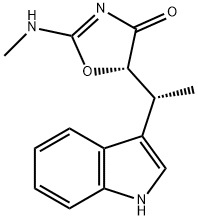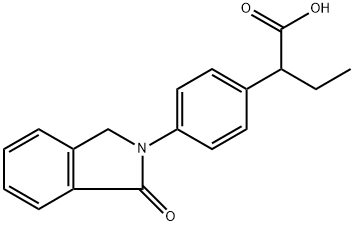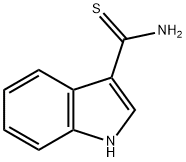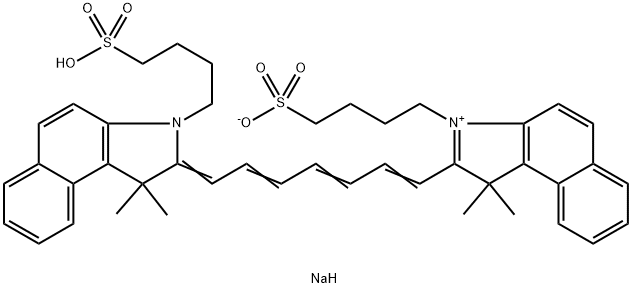(-)-Indolmycin
- CAS NO.:21200-24-8
- Empirical Formula: C14H15N3O2
- Molecular Weight: 257.29
- MDL number: MFCD01747966
- SAFETY DATA SHEET (SDS)
- Update Date: 2023-05-21 10:59:17

What is (-)-Indolmycin?
The Uses of (-)-Indolmycin
Indolmycin is a highly selective antibiotic which acts as a tryptophan anti-metabolite. Recent research has shown that indolmycin is active against Mycobacteria and H. pylori, and can stimulate transcription in Escherichia coli.
The Uses of (-)-Indolmycin
Indolmycin is an antibiotic that inhibits bacterial tryptophanyl-tRNA synthetase.
What are the applications of Application
Indolmycin is an antibiotic that inhibits bacterial tryptophanyl-tRNA synthetase
Definition
ChEBI: A member of the class of 1,3-oxazoles that is 1,3-oxazol-4(5H)-one which is substituted at the 2 and 5-pro-S positions by methylamino and [(1R)-1-(1H-indol-3-yl)ethyl] gro ps, respectively.
Biological Activity
indolmycin is an antibiotic.tryptophanyl-trna synthetase (trprs) catalyzes activation of tryptophan through atp and transfer to trnatrp , leading to translation of the genetic code for tryptophan.
in vitro
indolmycin was found to ba a bacteriostatic that showed good activity against methicillin-resistant s. aureus, methicillin-susceptible staphylococcus aureus, and vancomycin-intermediate s. aureus, including strains resistant to mupirocin or fusidic acid. spontaneous indolmycin-resistant mutants was observed at a lower frequency than those selected by mupirocin or fusidic acid and exhibited no cross-resistance with the comparative drugs. high-level resistance of indolmycin at its mic of 128 mg/l that was associated with an h43n mutation in tryptophanyl-trna synthetase, the target enzyme of indolmycin, led to loss of bacterial fitness. however, the locus responsible for low-level indolmycin resistance (indolmycin mics 8-32 mg/l) was not identified [1].
in vivo
animal study found that indolmycin could completely clear h. pylori in experimentally infected mongolian gerbils at a dose of 10 mg/kg. therefore, indolmycin could be regarded as a candidate for the treatment of h. pylori infection [2].
References
[1] hurdle jg, o'neill aj, chopra i. anti-staphylococcal activity of indolmycin, a potential topical agent for control of staphylococcal infections. j antimicrob chemother. 2004 aug;54(2):549-52. epub 2004 jul 8.
[2] vecchione jj, sello jk. a novel tryptophanyl-trna synthetase gene confers high-level resistance to indolmycin. antimicrob agents chemother 2009; 53: 3972-3980.
Properties of (-)-Indolmycin
| Melting point: | 209-210° |
| Boiling point: | 420.8±37.0 °C(Predicted) |
| alpha | D25 -214° (c = 2 in methanol) |
| Density | 1.36±0.1 g/cm3(Predicted) |
| storage temp. | Store at -20°C, protect from light |
| solubility | Soluble in ethanol;methanol;DMSO;dimethyl formamide |
| form | powder |
| pka | 16.65±0.30(Predicted) |
| color | white |
Safety information for (-)-Indolmycin
Computed Descriptors for (-)-Indolmycin
New Products
4-AMINO-TETRAHYDRO-PYRAN-4-CARBOXYLIC ACID HCL 4-(Dimethylamino)tetrahydro-2H-pyran-4-carbonitrile 4-Aminotetrahydropyran-4-carbonitrile Hydrochloride (R)-3-Aminobutanenitrile Hydrochloride 3-((Dimethylamino)methyl)-5-methylhexan-2-one oxalate 1,4-Dioxa-8-azaspiro[4.5]decane 5-Bromo-2-nitropyridine Nimesulide BP Aceclofenac IP/BP/EP Diclofenac Sodium IP/BP/EP/USP Mefenamic Acid IP/BP/EP/USP Ornidazole IP Diclofenac Potassium THOMAIND PAPER PH 2.0 TO 4.5 1 BOX BUFFER CAPSULE PH 9.2 - 10 CAP SODIUM CHLORIDE 0.1N CVS ALLOXAN MONOHYDRATE 98% PLATINUM 0.5% ON 3 MM ALUMINA PELLETS (TYPE 73) LITHIUM AAS SOLUTION 2-Bromo-1-(bromomethyl)-3-chloro-5-nitrobenzene 2-Bromo-3-nitroaniline N-(3-Hydroxypropyl)-N-methylacetamide 3-Bromo-6-chloropyridazine 4-ethyl-3-nitrobenzoic acidRelated products of tetrahydrofuran






You may like
-
 1-Methyl-6-oxo-1,6-dihydropyridazine-3-carbonitrile 98%View Details
1-Methyl-6-oxo-1,6-dihydropyridazine-3-carbonitrile 98%View Details
99903-60-3 -
 88491-46-7 98%View Details
88491-46-7 98%View Details
88491-46-7 -
 1823368-42-8 98%View Details
1823368-42-8 98%View Details
1823368-42-8 -
 2-(3-(tert-butyl)phenoxy)-2-methylpropanoic acid 1307449-08-6 98%View Details
2-(3-(tert-butyl)phenoxy)-2-methylpropanoic acid 1307449-08-6 98%View Details
1307449-08-6 -
 Ethyl 3-(furan-2-yl)-3-hydroxypropanoate 25408-95-1 98%View Details
Ethyl 3-(furan-2-yl)-3-hydroxypropanoate 25408-95-1 98%View Details
25408-95-1 -
 2-Chloro-5-fluoro-1-methoxy-3-methylbenzene 98%View Details
2-Chloro-5-fluoro-1-methoxy-3-methylbenzene 98%View Details
1805639-70-6 -
 1784294-80-9 98%View Details
1784294-80-9 98%View Details
1784294-80-9 -
 Lithium ClavulanateView Details
Lithium ClavulanateView Details
61177-44-4